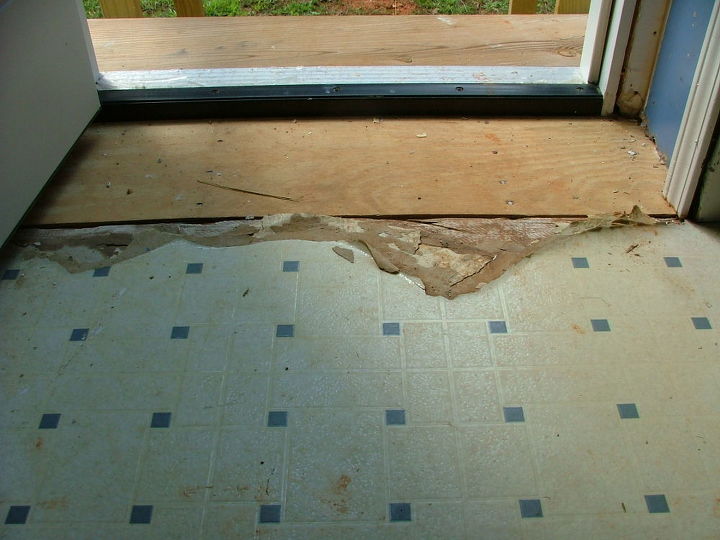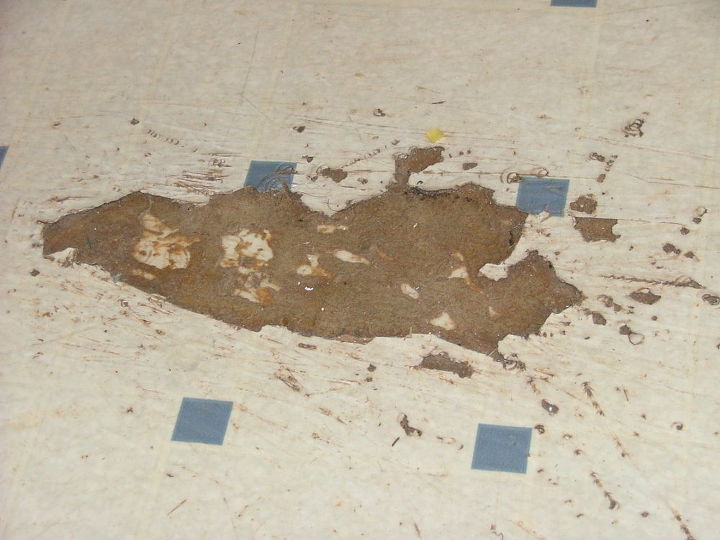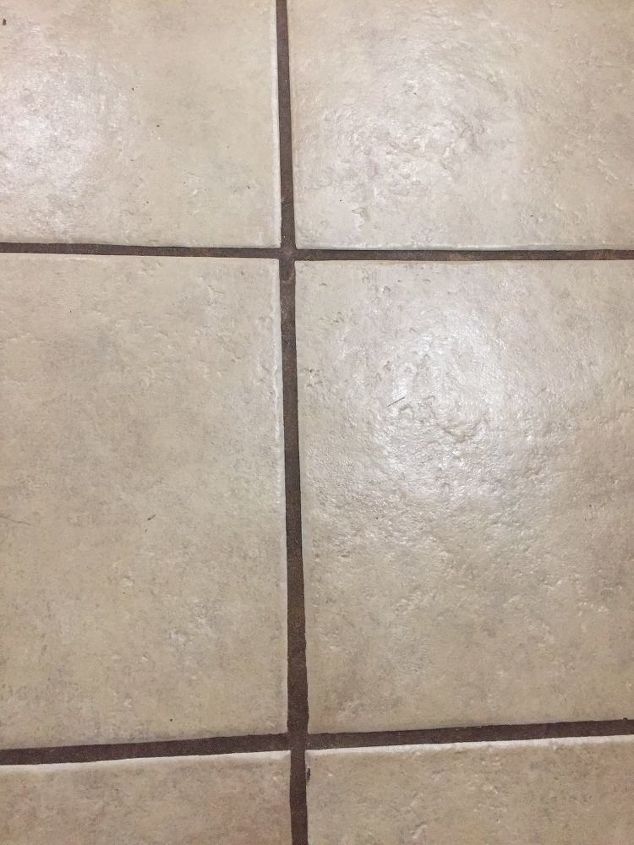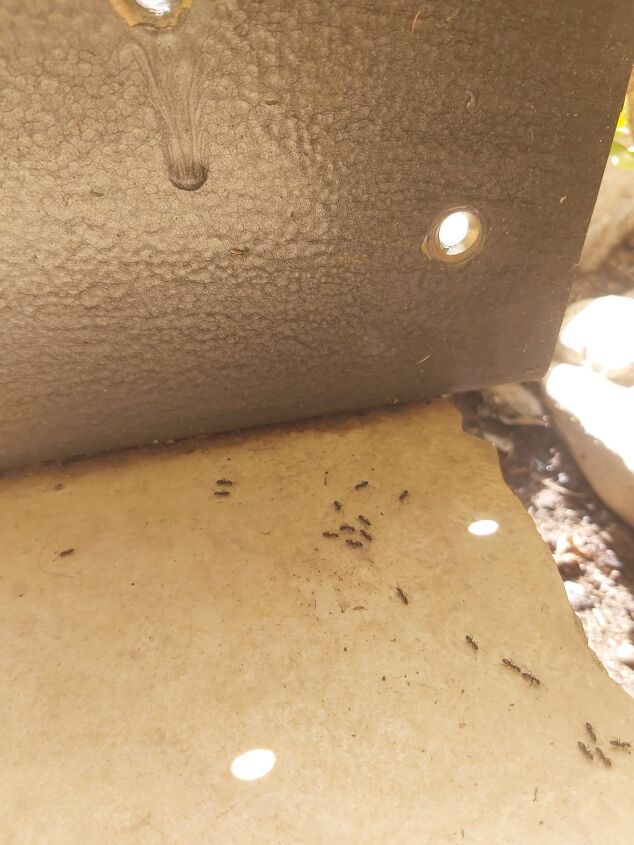I have another project to tackle, I have a kitchen floor shown in the pics, I want to replace this floor with ceramic

-
Looks like it was a sort of glue down Kenneth(but not too good of one!) When the time comes, I'd move the appliances out of the way and start pulling the vinyl floor up...I'd start at that weekened corner and use easy and steady pressure. If you find that it isn't coming up easy, then the original adhesive is doing it's job and you should be able to go right over it with ceramic tile, just make sure the floor is clean and is solid enough where the grout won't flex and crack. Best to you, thanks for the pix, much easier to advise! JL
 JL Spring & Associates
on Sep 26, 2011
Helpful Reply
JL Spring & Associates
on Sep 26, 2011
Helpful Reply -
-
I recommend pulling up all that vinyl flooring. Worth the effort in the long run, and it shouldn't be too hard. You might have some ugly adhesive residue, but you can find adhesive removers at any hardware store.
 3po3
on Sep 26, 2011
Helpful Reply
3po3
on Sep 26, 2011
Helpful Reply -
-
This citrus solvent works on a lot of those adhesives and smells good too!
 JL Spring & Associates
on Sep 26, 2011
JL Spring & Associates
on Sep 26, 2011
 Helpful Reply
Helpful Reply -
-
This could go either way...I know of many jobs were people will lay backer board over this and just tile away. The backer is set with adhesive and nailed or screwed in place. It is the cheaper and faster version of pulling it up. I have done it a couple of times that way at the insistance of the HO on a tight budget. Normally I whip out my trusty 6" wide bladed floor scrapper and have at it. Getting the vinyl up allows you to inspect the subfloor for damage or rot...which ALWAYS should be fixed before any long term tile project. If the sub-floor fails in 5 years due to old issues...the tile will also fail. From your pic it looks like some type of repair was done in front of the door...do you know the details about that?
 KMS Woodworks
on Sep 27, 2011
Helpful Reply
KMS Woodworks
on Sep 27, 2011
Helpful Reply -
-
Use 1/4 perma base before you lay your tile. I couldn't tell from the pictures if your subfloor was particle board of plywood. If particle board, you should replace it with a good grade of CDX plywood, then install your concrete board and tile. DO NOT TAKE SHORT CUTS ON THIS ONE OR YOU WILL BE WASTING YOUR MONEY. Improperly installed tile on a wood subfloor will crack.
 Metro Flooring & Design
on Sep 28, 2011
Helpful Reply
Metro Flooring & Design
on Sep 28, 2011
Helpful Reply -
-
Yes, peel it up. Pop that quarter round off at the basebd too. Oh, and get rid of the dog that dug this vinyl up. Second, pull that door and reset it over a membrane to protect the exterior subfloor or it will be rotting before you finish this job. Third if you have a particle bd underlayment, replace it with a second ply of plywood glued and screwed to give you a decent substrate. Then lay Ditra as a decoupling tile base, following the directions as to which thinset to use.
 Nichter's Home Services Corp
on Sep 28, 2011
Helpful Reply
Nichter's Home Services Corp
on Sep 28, 2011
Helpful Reply -
-
Pull it if you want it done right. Start fresh, no hiding the old...there are likely hidden issues anyway. It's worth your effort
 Imagery
on Oct 01, 2011
Helpful Reply
Imagery
on Oct 01, 2011
Helpful Reply -
-
You should pull the old vinyl and replace the osb with cdx plywood 5/8 or better depending on the substrate beneath. Then if using Hardi-Backer Board1/4" or 1/2" you should lay Liquid nails on the non grid side of it then it should always be screwed down with the BackerBoard designed screws and NOT nailed. The reason you dont nail this product onto a floor is because when setting tile you want to have as little movement as possible. If you nail it there is really nothing to stop the nail from backing out hence squeaking floors. Screws are the way to go it grabs, pulls, and stays in spot. Liquid nails or (construction adhesives) are used as an extra precaution only but not nessessity. back to nails and movement, if any movement occures the grouting will be the first thing to crack and break out then loose tiles and or broken tiles jsut get it done the right way first so you wont have to deal with the headache later
 Ji.flooring2009
on Oct 01, 2011
Helpful Reply
Ji.flooring2009
on Oct 01, 2011
Helpful Reply -
-
PJ is on the mark with this and don't forget to countersink the screws enough where you can spackle the screw holes so those indentations won't show through the new vinyl should you go that way. If replacing with tile or hardwoods, the indentations are a non-issue! Best of luck and show some project pix....JL
 JL Spring & Associates
on Oct 01, 2011
Helpful Reply
JL Spring & Associates
on Oct 01, 2011
Helpful Reply -
-
Right on PJ - all good advise given...if you've never done this kind of work...again..best left to pro's. Never nail subfloor or backerboard...just asking for problem....even though the websites say nailing is ok. From your pic....you're best to get it all out and start from scratch. Problem with overlaying in our area....you can create a mold trap between the old floor and the new floor. Good luck!
 HandyANDY - Handyman & All Repairs, LLC
on Oct 01, 2011
Helpful Reply
HandyANDY - Handyman & All Repairs, LLC
on Oct 01, 2011
Helpful Reply -
-
Yes, pull up that vinyl and make sure you are on level plywood before you lay cement board underlayment!! A perfect tile install is the result of making sure the substrates beneath are done correctly so as not to compromise the integrity of the tile on top!
 Moda Floors and Interiors
on Oct 24, 2011
Helpful Reply
Moda Floors and Interiors
on Oct 24, 2011
Helpful Reply -
-
Been there..We used a Heat gun made to remove vinyl tile. Time consuming but worth it in the long run. Otherwise have to put a liner and primer down to retile. Besides, you never know what you might find and like underneath. Let us know how it goes.
 Sheila D
on Apr 07, 2014
Helpful Reply
Sheila D
on Apr 07, 2014
Helpful Reply -
-
Time to pull it up and start from scratch. Is there hardwood flooring underneath or just subflooring? If you have a wood floor you going to need to put a barrier down to protect it. I would spend the time to give yourself a totally clean floor to lay your tile on. Before you lay the tile down I would think of where the worn spots are now. Are you going to change the placement of table so the traffic through the kitchen is different? If not, do you need to think of how to protect the tile surface.
 Irish53
on Jul 19, 2014
Helpful Reply
Irish53
on Jul 19, 2014
Helpful Reply -
Related Discussions
I have a light color grout in my ceramic floor in my kitchen and I can
How do you use washi tape?
Looking for ideas on how to use washi tape for DIY projects and crafts.Do you use it on notebooks, gift wrap, and journal pages?How about decor pieces and organizing ... See more
Is washi tape recyclable?
I'm moving to a new place and taking down my renter-friendly washi tape decor when I thought... wait, isn't this just paper? Can I chuck the washi paper in the recycl... See more
Can you write on washi tape?
I have some gorgeous translucent washi tape and I want to use it to label items. Has anybody written on washi tape before? If so, what type of pen/ink works best to s... See more
How effective are bay leaves for ants?
I'm dealing with a terrible ant infestation, and I heard that bay leaves can be a great way to keep them away. Do you know if that's true? If it is, how can I use bay... See more
Does anyone have any good suggestions on how to keep squirrels out of my bird feeders?
I have tried the crushed red pepper in the bird seed, and have tried putting vaseline on the pole that holds the feeders....any other suggestions? I will at times hav... See more
How to clean a mirror without streaks?
Every time I clean my mirrors, they end up having tons of streaks and almost look worse than before I started. What could I use to clean them that won't leave streaks... See more







